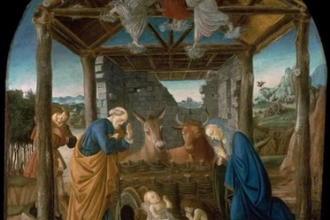Gospel in Art: A sound tree produces good fruit

Fruits, by Yayoi Kusama (b. 1929), painted in 1996 © Bonhams London, 24 March 2022, lot 6
Source: Christian Art
Gospel of 26 June 2024
Matthew 7:15-20
Jesus said to his disciples: 'Beware of false prophets who come to you disguised as sheep but underneath are ravenous wolves. You will be able to tell them by their fruits. Can people pick grapes from thorns, or figs from thistles? In the same way, a sound tree produces good fruit but a rotten tree bad fruit. A sound tree cannot bear bad fruit, nor a rotten tree bear good fruit. Any tree that does not produce good fruit is cut down and thrown on the fire. I repeat, you will be able to tell them by their fruits.'
Reflection on the painting
Many of the images Jesus uses in the Gospels have a striking quality to them. This is evident in today's gospel reading, with its image of a wolf disguised as a sheep. The wolf is the enemy of the sheep. In John's Gospel, Jesus speaks of the hired hand who, unlike the shepherd, abandons the sheep and runs away when he sees the wolf coming. Consequently, the wolf snatches the sheep and scatters them. The contrast between appearance and reality is vividly captured in the image of a wolf in sheep's clothing, a phrase that has entered our language.
Jesus then shifts from animal imagery to plant imagery, stating that the quality of the fruit reveals the quality of the tree that produced it. In other words, returning to the animal metaphor, even if the wolf is disguised as a sheep, its true nature will eventually be revealed. Pretences cannot be maintained indefinitely. The quality of our heart will be shown through the quality of our lives. Paul describes the fruit of the Spirit as love, joy, peace, patience, kindness, generosity, faithfulness, gentleness, and self-control. When such fruit is evident in a person's life, it shows that their core is sound and that their heart is aligned with the Lord's heart.
Our painting is by Yayoi Kusama, executed in 1996. The Japanese contemporary artist is known for her prolific use of polka dots. Kusama's journey as an artist began in post-war Japan, but she gained international acclaim after moving to New York City in the late 1950s. Her work spans various mediums, including painting, sculpture, installation, and performance art. When Kusama paints fruit, she infuses these everyday objects with her signature polka dots and repetitive patterns, transforming them into mesmerising visual experiences. Our painting is very small, yet it is has such a presence. Kusama's use of bold colours and meticulous detail elevates the fruit beyond mere representation, turning it into hypnotic pieces that challenge viewers' perceptions and evoke a sense of wonder. The quality of the painted fruit reveals the quality of the artistic tree it came from, the artist.
LINKS
Gospel in Art: https://christian.art/
Today's Reflection: https://christian.art/daily-gospel-reading/matthew-7-15-20-2024/


















